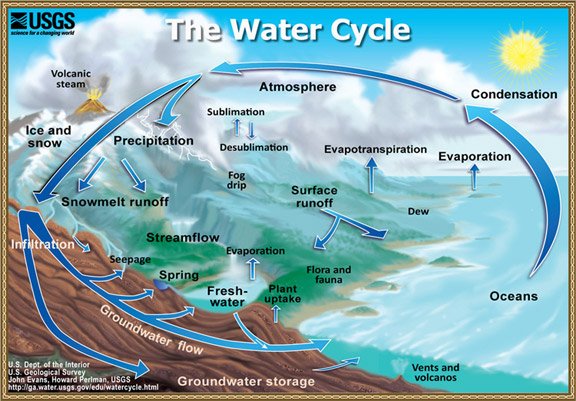Where Does Our Water Come From?
Water is required in varying degrees by every living thing. We humans, depending on the individual, can only live four to ten days without it. Water is considered a finite resource, meaning that we have the same amount of water on earth now that we had thousands of years ago. However, there are now billions of people and entities on earth all competing for the same amount of water. It may be distributed differently around the world, and it may be at a different place in its continuous cycle (please see “The Water Cycle” or illustration of the water cycle below), but there is no new water being created. It is becoming more and more precious every day.
The continuous water cycle starts with rain. Of the rain that falls on the land, 89% of it either evaporates directly to the atmosphere or processed through transpiration in plants into the atmosphere. The remaining 11% seeps into the ground or runs off as surface water to rivers and streams. Of the water on the earth’s surface, 97% of it is saltwater and 1-2% is frozen glaciers, ice, and snow around the world. That leaves about 1% of water available for consumption.
Only 4% of the water that falls on the ground as rain actually recharges the underground aquifers and is known as groundwater. Some of the water that enters the aquifers returns to the surface as springs, streams, or surface water. San Marcos Springs, Blue Hole, and Jacob’s Well are a few examples. Likewise, some of the water in springs and streams enters the aquifers and becomes groundwater. In many parts of the country, groundwater is pumped to the surface for use as potable or irrigation water. In Hays County, we get groundwater from private and commercial wells drilled into the Trinity and Edwards Aquifers as well as surface water through pipelines from the Colorado River (Lower Colorado River Authority) and Canyon Lake (Guadalupe-Blanco River Authority). The Hays-Trinity Groundwater Conservation District, whose mission is to conserve, preserve, recharge, and prevent waste of groundwater within western Hays County, has permitted the drilling of 3,000 private and commercial wells into the Trinity Aquifer since 2001. Prior to that, wells were not required to be permitted, so there are many, many more than that number drilled into the Trinity Aquifer, which is our primary source of groundwater.
Since the volume of water in the world never changes and the population of the world is increasing, we must begin to think more about how we manage water. Factors that we need to consider include the growing demand on the water supply, depleting aquifers, increasing water pollution and global climate change. We really need to begin looking at the bigger picture and act accordingly.

